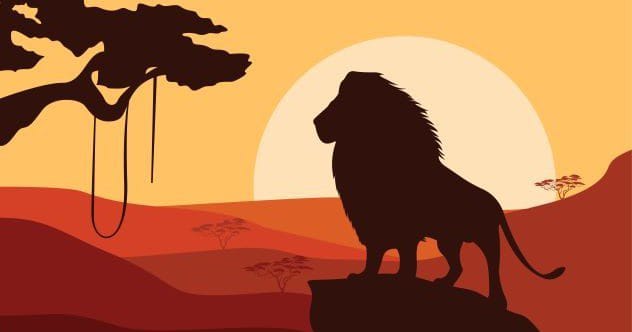The Lion King, released on June 15, 1994, by Walt Disney Feature Animation, charmed audiences with its moving story, memorable music, and stunning animation. While many know the basic story, some fascinating details about the movie’s creation remain hidden. Here are ten things you may not have known about the production of The Lion King.
The Animation Was Initially Assigned to B-Team Animators
Believe it or not, The Lion King was initially animated by what Disney considered its “B-Team.” The studio placed its bets on Pocahontas (1995), believing it had greater potential. The A-Team animators were assigned to Pocahontas, while The Lion King team worked diligently, proving that passion trumps perceived importance. Despite a budget of $250-$260 million, the movie roared to a worldwide gross of $1.12 billion, surpassing expectations. [1]
The Film Almost Went by ‘King of the Jungle’
Imagine a different title! Early on, the movie was nearly named The King of the Kalahari before evolving into King of the Jungle. However, producers soon realized a glaring issue: the film is set in a savannah, not a jungle. This realization led to the iconic and geographically accurate title we know and love today: The Lion King. [2]
Production Was Temporarily Halted by an Earthquake
Disaster struck on January 17, 1994, when an earthquake hit Los Angeles, disrupting The Lion King’s production with only six months until its release. The quake caused disruptions at Walt Disney Animation Studios and affected transportation. Some animators braved the commute, while others chose to sleep at the studio.
The studio eventually shut down completely, forcing animators to work from home. The production team scrambled to shuttle artwork and materials to animators’ homes to keep the project on track. Despite these challenges, their dedication ensured the film’s timely release – a truly remarkable feat. [3]
A Connection to ‘Coming to America’
Did you know that the voices of King Mufasa and Queen Sarabi, Simba’s parents, were provided by James Earl Jones and Madge Sinclair? This duo also played the king and queen in the 1988 film Coming to America. The casting choice adds a regal touch to The Lion King, connecting two beloved movies through iconic performances. [4]
The Hyena March Scene Was Inspired by Nazi Germany
The “Be Prepared” scene, where Scar unveils his plan to usurp Mufasa, draws inspiration from an unexpected source: Nazi propaganda film Triumph of the Will. Jorgen Klubien, a member of the production team, envisioned Scar as a Hitler-like figure. The directors embraced this concept, mirroring the Nuremberg-style rallies in the film.
The hyenas in the scene are arranged in formations reminiscent of Nazi rallies. Scar’s position overlooking his hyena army mirrors Hitler’s portrayal in the documentary, adding a dark, historical layer to the animated film. [5]
Animators Journeyed to Kenya for Authentic Inspiration
To capture the true essence of the African landscape, The Lion King’s animators visited Hell’s Gate National Park in Kenya. The valleys in the wildebeest stampede scene and Pride Rock itself were inspired by the park’s unique rock formations. Ironically, Hell’s Gate National Park is not home to lions, allowing the animators to soak in the savannah’s beauty without disturbance. The park is also unique in that visitors can explore it on foot. [6]
The Original Director Left When the Film Became a Musical
George Scribner, known for directing Oliver & Company (1988), was initially chosen to direct The Lion King. However, after six months of development, Scribner clashed with producers over their decision to make the movie a musical. Scribner envisioned a non-musical animated feature, and when it became clear he wouldn’t get his way, he left the project. Despite this, The Lion King defied expectations and became a massive success, with Scribner’s best-known work remaining Oliver & Company. [7]
A Memorable Three-Minute Scene Took Three Years to Animate
The heart-wrenching scene where young Simba is tricked by Scar into a canyon and caught in a wildebeest stampede took a staggering three years to animate. Mufasa’s heroic rescue and tragic death in this scene are pivotal moments in the film. Animating the three-minute sequence was particularly challenging because it was computer-generated, a relatively new technology at the time. The animators’ dedication to perfecting this scene paid off, making it one of the most memorable in cinematic history. [8]
A Hyena Expert Sued Disney for Defamation
The hyenas in The Lion King, portrayed as Scar’s villainous collaborators, faced criticism for their negative depiction. Disney animators visited the University of California’s Field Station for Behavioral Research, ostensibly to observe hyenas firsthand. It’s believed that the research facility only cooperated because Disney allegedly promised a positive portrayal of the animals.
Following the film’s release, a hyena research biologist sued Disney for defaming the character of hyenas, reflecting the real-world impact of the film’s narrative choices. [9]
A Real Lion Was Brought into the Animation Studio
To achieve maximum realism, the animators of The Lion King took an extraordinary step: they brought a real lion into the studio. This allowed them to accurately observe the animal’s movements and mannerisms. Other animals were also brought in for observation. Animators drew scenes in pencil, which were then scanned into Disney’s Computer Animation Production System (CAPS), a relatively new technology at the time. Painters digitally colored the drawings, superimposing them onto painted backgrounds before transferring everything to film. [10]
These fascinating facts reveal the dedication, challenges, and creative choices that shaped The Lion King into the classic we cherish. From animation team dynamics to real-life inspirations, the journey behind this film is as captivating as the story itself.
What’s your favorite memory of watching The Lion King? Share your stories in the comments below!










